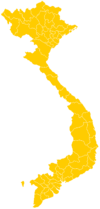Related Research Articles
Present-day telecommunications in Canada include telephone, radio, television, and internet usage. In the past, telecommunications included telegraphy available through Canadian Pacific and Canadian National.
Telecommunications in Peru include radio and television, fixed and mobile telephones, and the Internet.
Telecommunications in Slovakia includes fixed and mobile telephones, radio, television, and the Internet.

Hồ Chí Minh, also referred to as Saigon, is the largest city of Vietnam. According to the 2019 census, Ho Chi Minh City has a population of over 8.9 million within city proper and over 21 million within the metropolitan area. Located in southeastern Vietnam, the city surrounds the Saigon River and covers about 2,061 square kilometres. Ho Chi Minh City is the economic and financial centre of Vietnam, and plays an important role in the country's culture and scientific developments.

This article is about telecommunications systems in Armenia.

Beeline, earlier Bee Line GSM is a telecommunications brand by company PJSC VimpelCom, founded in Russia.

Golden Telecom is a company that provides communication and Internet services in Russia and the Commonwealth of Independent States (CIS).
S-Fone is a mobile communication operator in Vietnam that uses the CDMA technology. Founded on 1 July 2003 in Ho Chi Minh City, Vietnam, S-fone became the third network of Vietnam, breaking the duopoly of the two VNPT operators. It is the trademark of S-Telecom. SK Telecom decided to leave the partnership in 2010. SPT has since then found it difficult to find a new partner, after a co-operation with Saigon Tel failed.

VEON Armenia CJSC is an Armenian broadband and telecommunications company. «VEON Armenia» CJSC is part of VEON, one of the world’s largest integrated telecommunications services operators, headquartered in Amsterdam, the Netherlands.
Vietnam Mobile Telecom Services One Member Limited Liability Company is a major Vietnamese mobile network operator headquartered in Trung Hoa Nhan Chinh, Hanoi. Founded on 16 April 1993, as a Global System for Mobile Communications launcher, MobiFone is the first and currently third largest telecommunications provider in Vietnam.
Vinaphone is a Vietnamese major mobile network operator headquartered in Hanoi, Vietnam. Founded on 26 June 1996, as a GSM launcher, Vinaphone is the second network and currently the second largest provider in Vietnam. VinaPhone was the first network operator to launch 3G services nationwide.

ViettelGroup is a Vietnamese multinational telecommunications company headquartered in Hanoi, Vietnam. Viettel is the largest telecommunications service provider in Vietnam. It is a state-owned enterprise and operated by the Ministry of Defence.

The mobile phone industry in Russia has expanded rapidly to become one of the largest in the world. In terms of number of smartphone users, Russia is the 4th biggest smartphone market in the world sitting behind only China, India, and USA.

Ihor Volodymyrovych Lytovchenko is a founder and permanent head of the Kyivstar company since 1994. He is the chairman of the management board, and the head of business unit VimpelCom Ltd. For 15 years, Ihor Lytovchenko has been developing one of the most successful business projects in Ukraine. Under his command, Kyiv local cellular company has taken a leadership position in the national telecommunications market, providing services to 27 million subscribers around Ukraine.

VEON Ltd. is a Dutch-domiciled multinational telecommunication services company headquartered in Amsterdam, Netherlands. It predominantly operates services in the regions of Asia, Africa and Europe. It is the ninth largest mobile network operator in the world by number of subscribers with 214 million customers. More than half of the company's revenue comes from Russia.
Vietnamobile is a Vietnamese mobile network operator. It is a joint-venture of Hanoi Telecom and Hutchison Asia Telecom Group and the fourth largest provider as of 2012.

Gmobile is a Vietnamese mobile network operator. The brand Gmobile is owned by GTel Mobile and is the successor of Beeline Vietnam. GTel in turn is owned by Global Telecommunications Corporation, a state-owned joint-stock company under the Ministry of Public Security.

Viettel Tanzania Public Limited Company, trading as Halotel,is a mobile communications company, providing voice, messaging, data and communication services in Tanzania. It is owned by Viettel Global JSC which is the state-owned Investment Company from Vietnam investing in the Telecommunications market in several countries worldwide. It has invested up to $1 Billion into the Tanzania's telecommunications market. The Company was the first company in Tanzania allowed to lay its own fiber optic cable and has placed over 18,000 km of optic fibers, providing all 26 regions of Tanzania services.
References
- ↑ CIA World Fact Book
- ↑ Netviettel.com
- ↑ Mobifone.com.vn
- ↑ Vinaphone.com.vn
- ↑ Sfone.com.vn Archived 2006-08-24 at the Wayback Machine
- ↑ Vietnammobile.com.vn Archived 2010-02-17 at the Wayback Machine
- ↑ Beeline.vn Archived 2010-01-22 at the Wayback Machine
- ↑ http://vietnamnet.vn/vn/cong-nghe-thong-tin-vien-thong/81135/s-fone-da-gan-nhu-ngung-hoat-dong.html
- ↑ http://www.qdnd.vn/qdndsite/vi-vn/61/186301/print/Default.aspx
- ↑ http://vietnamnet.vn/vn/cong-nghe-thong-tin-vien-thong/80806/doanh-nghiep-vien-thong--nhom-ngo--bang-tan-cua-s-fone.html
- ↑ CIA World Fact Book
- ↑ Maierbrugger, Arno (3 July 2013). "Internet usage in Vietnam takes off". Inside Investor. Retrieved 24 July 2013.

